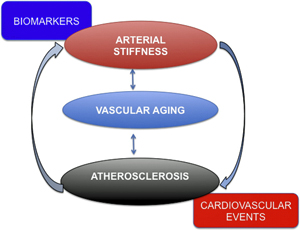|
Home Page
Known About Fluoride
Toothpaste Warning
Interferes with Brain
Fetal Vulnerability
Neurotoxicity
Genetic Factor
Needs to Be Known
Fetal Fluoride Intake
Fluoride Drugs
Amniotic Fluid
Bogus Sales Pitch
Oregon Deception
Crazy Advice
Premature Birth
Infants Overdosed
Infant Mortality
Life Decay
Mental Fluorosis
Fluoride and
Neurodegeneration
End Fluoridation
Save $Billions
Know News
Prenatal Microbiome
Fluoride & Obesity
Vascular Dementia
Arterial Stiffness
2019 Studies
Fluoridation 'Science'
CDC's Irrationale
EPA's Pollutant
PHS's Debunkery
The Book
Contents
Author
|
Arterial Stiffness and Vascular Aging

The biological aging process is
always associated with arterial stiffness.
Fluoride and Arterial Stiffness
A study published in May 2018 found that reduced cognitive performance in older people is independently associated with aortic stiffness.[1]
As discussed in the book section, "Fluoride: Hypertension, Arterial Stiffness, and Preeclampsia" (pages 34-35), fluoride and fluorosis increase arterial calcification and stiffening that lead to hypertension.
PET/CT scans show a significant correlation between fluoride uptake and calcification in most of arterial walls. "The coronary fluoride uptake value in patients with cardiovascular events was significantly higher than in patients without cardiovascular events."[2]
In people with fluorosis, the elastic properties of the ascending aorta are impaired.[3]
The risk of hypertension prevalence increased by 22% when fluoride levels in drinking water increased from 0.84 to 1.55 mg/l.[4]
Note: US drinking water is 'optimally' fluoridated at 0.7 to 1.2 mg/l
with a Recommended Control Range allowing 1.7 mg/l. Worse, school water systems could be fluoridated at levels up to 4.5 times higher than communities.
"Vascular Aging and Arterial Stiffness," a September 2017 review:
"The biological aging process is always associated with arterial stiffness, which is accelerated by arterial hypertension." Worldwide, it's estimated that 9.4 million deaths per year are related to arterial hypertension, a highly relevant risk factor for stroke, coronary artery disease, and heart failure.[5]
|
Arterial stiffness is involved in most major diseases whose costs
and prevalence are detailed at End Fluoridation: Save $Billions.
Arterial stiffness is one of fluoride's pathological
processes documented at Mental Fluorosis.
References
1. Kennedy G, Meyer D, Hardman RJ, et al. Physical fitness and aortic stiffness explain the reduced cognitive performance associated with increasing age in older people. J Alzheimers Dis. 2018;63(4):1307-1316.
2. Li Y, Berenji GR, Shaba WF, et al. Association of vascular fluoride uptake with vascular calcification and coronary artery disease. Nucl Med Commun. 2012 Jan;33(1):14-20.
3. Varol E, Akcay S, Ersoy IH, et al. Aortic elasticity is impaired in patients with endemic fluorosis. Biol Trace Elem Res. 2010 Feb;133(2):121-127.
4. Sun L, Gao Y, Liu H, et al. An assessment of the relationship between excess fluoride intake from drinking water and essential hypertension in adults residing in fluoride endemic areas. Total Environ. 2013 Jan 15;443:864-869.
5. Mikael LR, Paiva AMG, Gomes MM, et al. Vascular aging and arterial stiffness. Arq Bras Cardiol. 2017 Sep;109(3):253-258.
|
"Gut microbiome diversity is inversely associated
with arterial stiffness in women." [Menni et al. 2018]
African American children are more vulnerable to fluoride's toxicity. They have significantly higher rates and more severe forms of dental fluorosis than either white or Hispanic children. A study of African American and white 7-14 years olds found that even though both groups had the same fluoride concentrations in their drinking water and saliva, dental fluorosis was 28% higher in African American children. – Connett (2012), Martinez-Mier (2010)
Black Americans Have a Higher Prevalence
of Cardiovascular Disease (CVD)
"In this biracial community-based sample, we demonstrate that black race is associated with impaired vascular function compared with whites. Specifically, blacks had (1) reduced microvascular endothelial function measured as RHI; (2) abnormal arterial wave reflections, measured as higher PAT-AIx and CAIx; and (3) greater arterial stiffness, measured as higher PWV, even after adjustment for traditional CVD risk factors. Importantly, these differences were present even in the subgroup of participants who were completely free of conventional CVD risk factors."
Morris AA, Patel RS, Binongo JN, et al. Racial differences in arterial stiffness and microcirculatory function between Black and White Americans. J Am Heart Assoc. 2013 Apr 8;2(2):e002154.
|
|